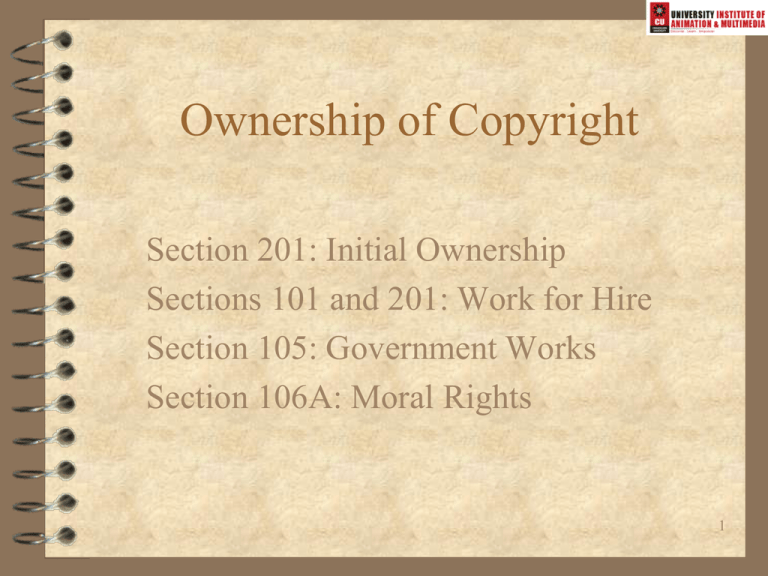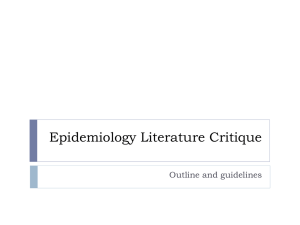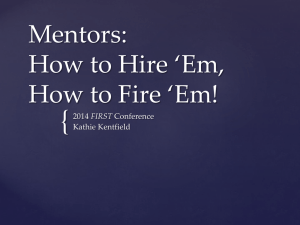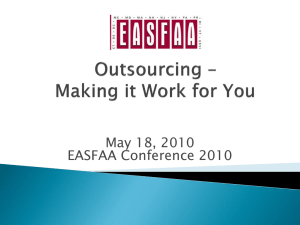Ownership of Copyright
advertisement

Ownership of Copyright Section 201: Initial Ownership Sections 101 and 201: Work for Hire Section 105: Government Works Section 106A: Moral Rights 1 Copyright versus Copy Copyright is intangible personal property Copy is by definition a tangible embodiment of the copyrighted work Thus, ownership of the copyright is distinct from ownership of any one copy or phonorecord Example: An artist paints and then sells a work of fine art. The artist retains the exclusive right to reproduce the work, while the buyer has a limited right to display the work. The right to sell, dispose of, or display the work is recognized pursuant to section 109, Limitations on exclusive rights: Effect of transfer of particular copy 2 Types of Copyright Ownership Joint Works - prepared by two or more authors who intend their contributions to be inseparable – Examples: motion pictures, musical score – Consequences: co-ownership (T in C, with right to grant nonexclusive license w/o consent of others, but must share profits) Collective Works - multiple contributions of separate and independent works that are assembled together – Examples: issues of periodicals, anthologies, and encyclopedias – Consequences: Copyright in the separate pieces for the respective authors and copyright for the author of the collective work (caveat?). Each contributor is presumed to 3 retain ownership of his respective piece Source of Law Initial Owner/Author Section 201(a) which states: – “Copyright . . . vests initially in the author or authors of the work.” – While author is not defined, courts look to case law as well as the negative language of 102(b) to develop a definition of authorship – Cases define author as “he to whom a work owes its origin – Section 102(b) states what works will not be deemed original, i.e., ideas or principles 4 Authors and Termination Rights Section 203 provides authors and, in most cases, their heirs with the following: – a right to terminate a transfer or copyright of a license during the authors lifetime – a termination right to the owner of the copyright upon the death of the initial author – a termination right to a majority of the authors of a joint work who executed the transfer Section 203 also describes the method to terminate the grant of a transfer or license as well as the effect of termination on derivative works prepared under the authority of the grant of license or transfer 5 Source of Law for Work for Hire Section 201(b) provides: – The employer for whom the work was prepared is the author and owner of the copyright, unless the parties have expressly agreed in writing to another arrangement Section 101 defines a work made for hire as: – Class 1: a work prepared by an employee within the scope of his or her employment – Class 2: specially commissioned works are works for hire if two conditions are met • contractual agreement that work is for hire • work falls within one of nine statutory categories 6 Employee versus Independent Contractor The Supreme Court settled the confusion with its decision in Community for Creative Non-Violence v. Reid, 490 U.S. 730 (1989). Was Reid an employee or an independent contractor? What is the test? Test: Case by case, multi-factor agency test – skill required, source of the tools, location of the work, relationship of the parties, control over the work or worker, discretion of the laborer, method of payment, and tax treatment, etc. – In essence, a totality of the circumstances test 7 What does it all mean????? If the work is made for hire, then the copyright belongs to the employer If the work is not made for hire, then the copyright belongs to the author or authors (Refer to CCNV v. Reid for the reason authors is plural) Examples of Independent Contractors – Freelance photographers – Independent computer programmers and consultants – NOTE: IC status does not foreclose the author from contracting away his copyright 8 Works Made for Hire and Termination Rights Unlike initial authors, employers who become authors as a result of works made for hire do not gain the right to terminate grants and licenses after thirty-five years Reasons: – The employer is deemed a sophisticated author – The employer maintains a bargaining position equal to a sophisticated exploiter of works – the employer, in an arm’s length transaction, can contract away the right of termination through 9 execution of a written agreement Government Works Section 105 does not allow the United States Government to avail itself of copyright protection However, the United States Government may receive and hold copyrights transferred to it by assignment or bequest 10 Moral Rights and Section 106A: The French Were Right! Moral Rights encompass the rights of attribution and integrity The moral right is a separate, non-transferable right that remains with the author, even after the transfer or license of a copyright The moral right protects against alteration, mutilation, or destruction of the work, even after transfer or license of a copyright 11






